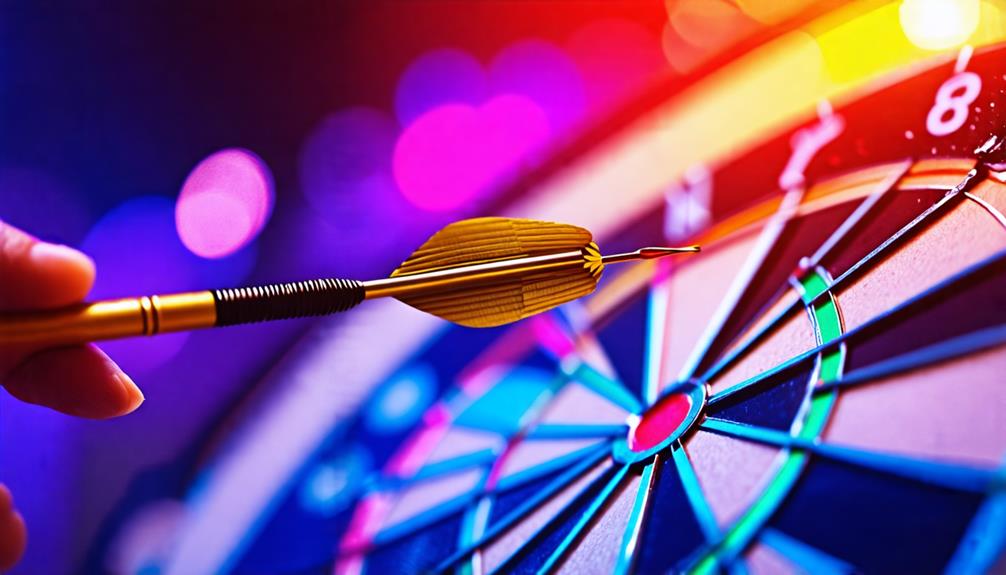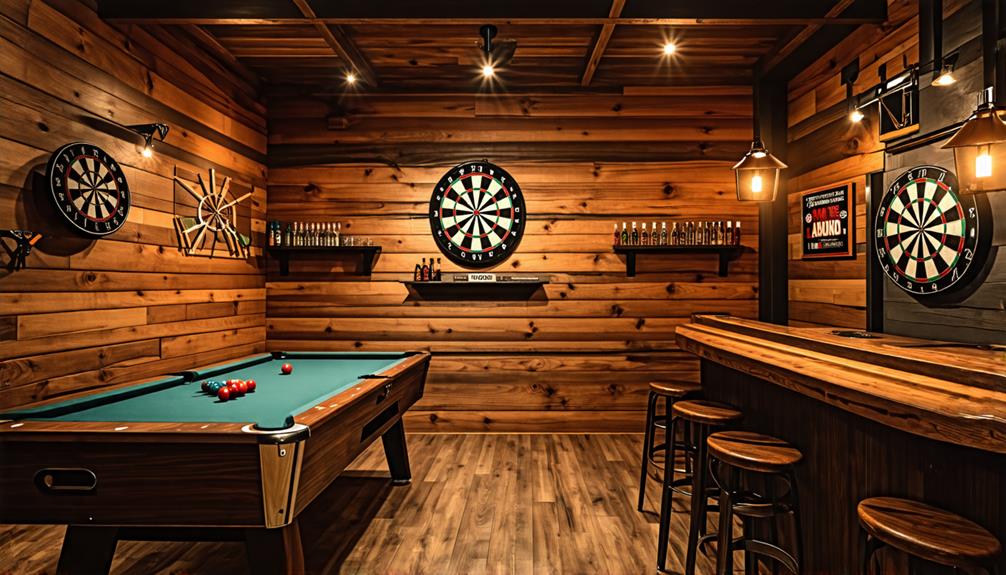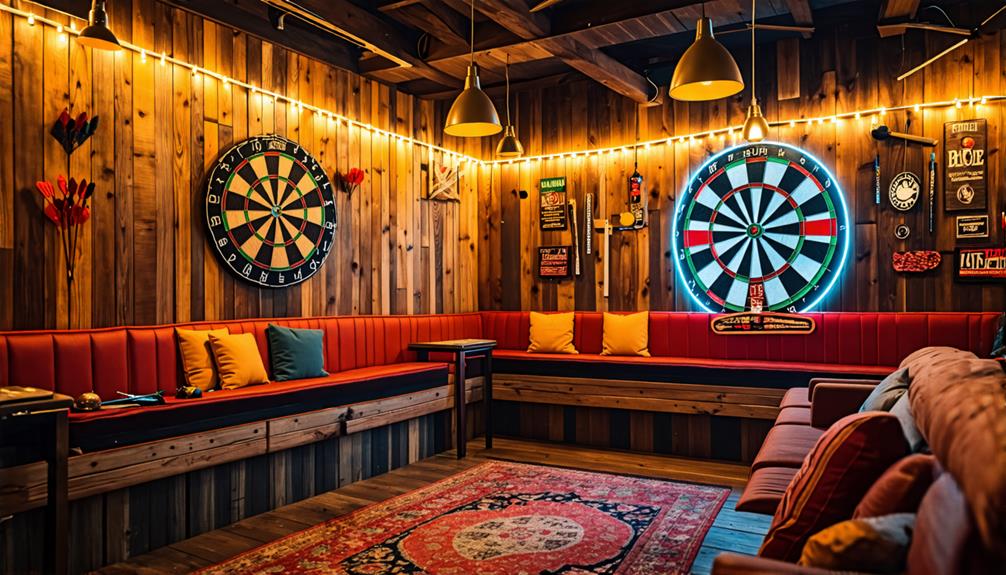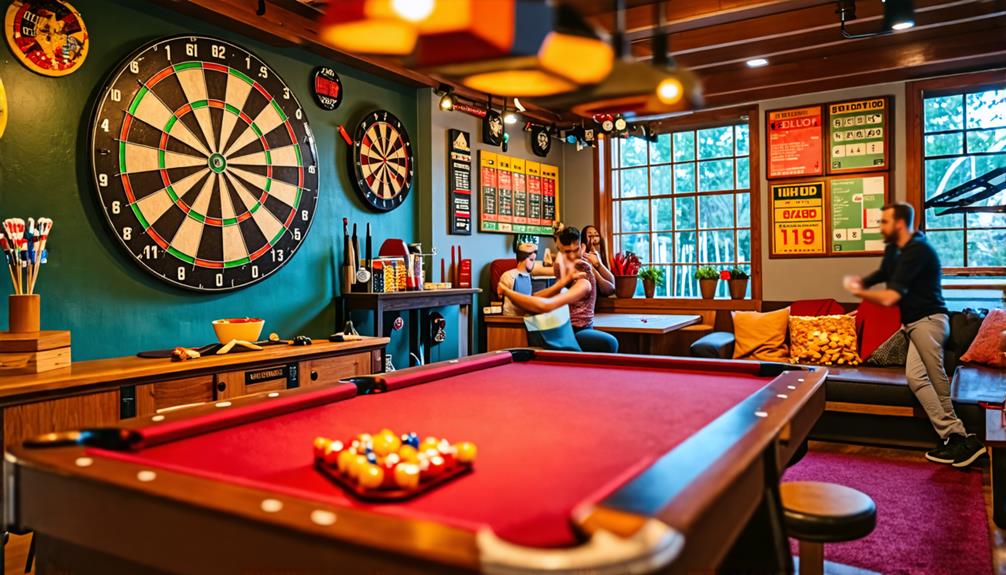Dartboard Maintenance Tips: Keep Your Board in Top Shape
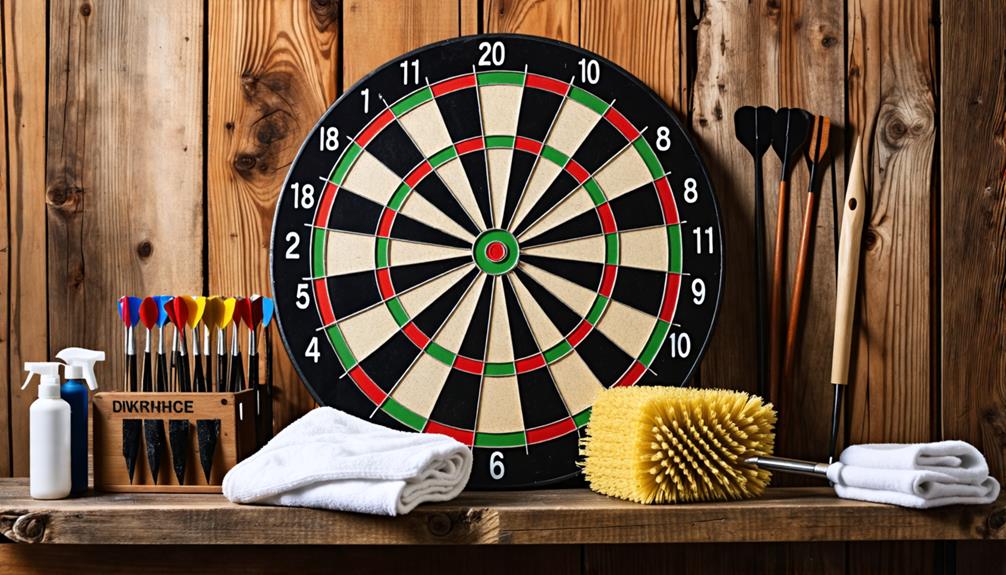
For optimal performance, regular dartboard maintenance is essential. Rotate your board monthly to ensure even wear, and keep it dry to prevent moisture damage. Cleaning it with a damp cloth can also make a significant difference. But that's just the beginning—several additional steps can help optimize your setup and protect your board from environmental factors. Interested in how these tips can enhance your playing experience?
Importance of Dartboard Maintenance
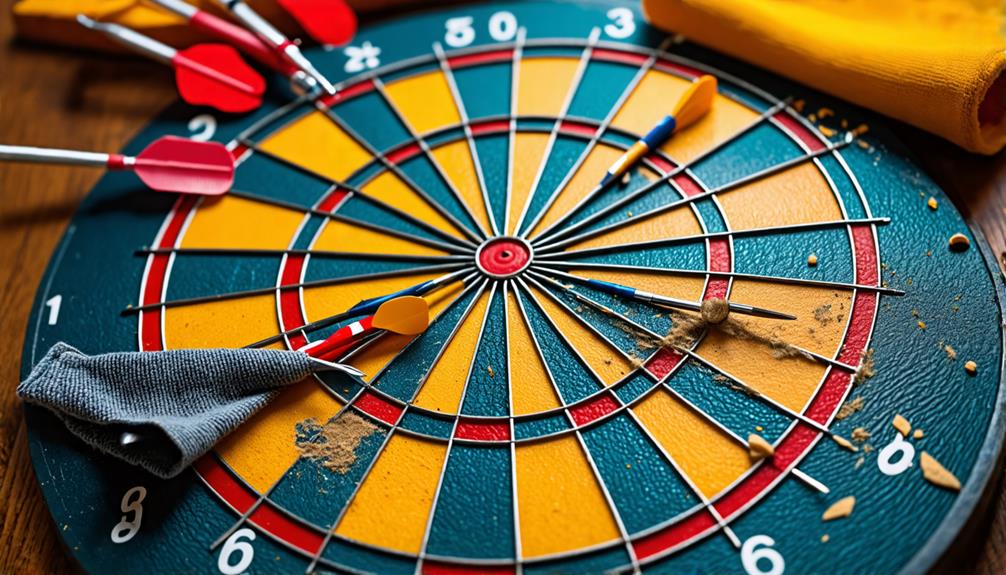
Maintaining your dartboard is crucial for ensuring longevity and optimal performance. Regular upkeep not only extends the lifespan of your dartboard but also provides a consistent playing experience. Continuous use can lead to wear and tear, making proper care essential. One of the primary threats to your dartboard is moisture. Keeping it in a dry environment is vital, as exposure to moisture can cause swelling, warping, and degradation of the sisal fibers, resulting in significant damage and a shortened lifespan. Regular cleaning is equally important. Use a soft cloth to remove dust and debris, and inspect the dartboard for any loose staples or signs of damage. These simple steps help maintain the integrity of the playing surface and ensure a reliable game every time.
Regularly Rotate Your Dartboard
Regularly rotating your dartboard can significantly extend its lifespan and ensure a consistent playing experience. By doing so, you distribute wear evenly across all segments, preventing concentrated damage in frequently hit areas. Ideally, you should rotate your dartboard at least once a month, particularly if you play often.
To rotate the board, remove the number ring, rotate it clockwise, and replace it with the 20 segment on top. This simple process is facilitated by modern dartboards designed with easy-to-rotate features and detachable frames. Consistent rotation not only enhances your board's durability but also ensures that all segments are used evenly. This prevents some sections from wearing out prematurely while others remain in good condition.
Keep Your Dartboard Dry
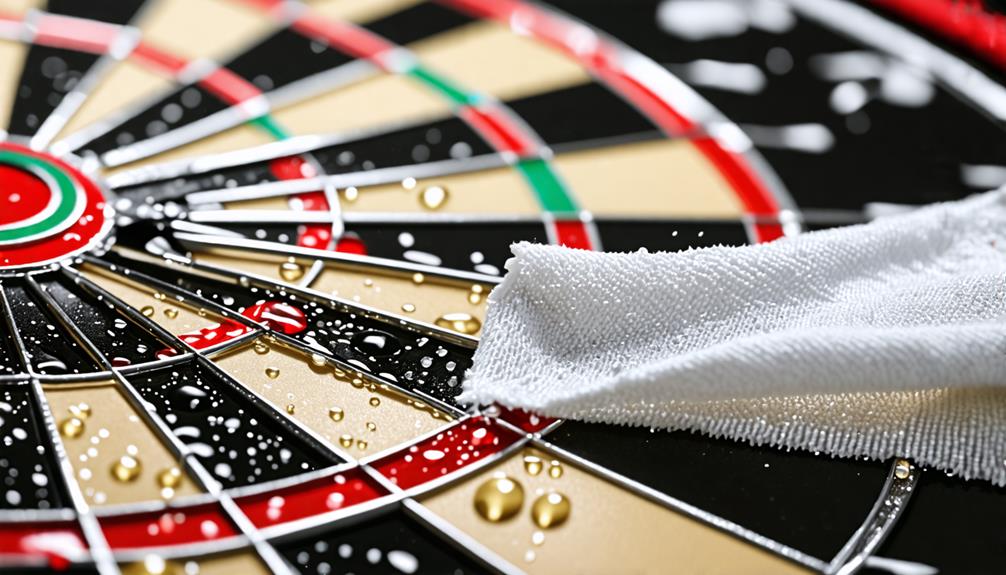
Ensuring your dartboard remains dry is crucial to prevent moisture-related damage that can affect its performance and longevity. Dartboards, particularly those made from sisal, should never come into contact with water, as moisture can cause swelling, warping, and the separation of fibers, ultimately damaging the board.
Here is a quick reference table to help maintain your dartboard:
| Action | Importance | Tips |
|---|---|---|
| Avoid humid areas | Prevents mold and mildew growth | Choose a dry location for your board |
| Use a damp cloth | Minimizes excess moisture | Wipe gently without soaking |
| Store properly | Preserves structural integrity | Keep away from direct sunlight |
| Regular checks | Detects potential issues early | Inspect for dampness regularly |
| Control humidity | Maintains low moisture levels | Use a dehumidifier if necessary |
Clean Your Dartboard Properly
To preserve your dartboard's performance and longevity, it's crucial to clean it properly. Start by wiping the surface with a soft, slightly damp cloth. Avoid using harsh chemicals, as they can damage the sisal fibers and compromise your board. Regularly inspect your dartboard for loose fibers and gently remove them to maintain a smooth playing surface and prevent uneven wear. A lint roller can effectively remove dust and loose debris, ensuring a cleaner playing area. For deeper cleaning, avoid using water directly on the board. Instead, use a vacuum with a brush attachment to carefully remove dust without compromising the board's structure. This method ensures proper cleaning while preserving your dartboard's longevity.
Inspect for Damage
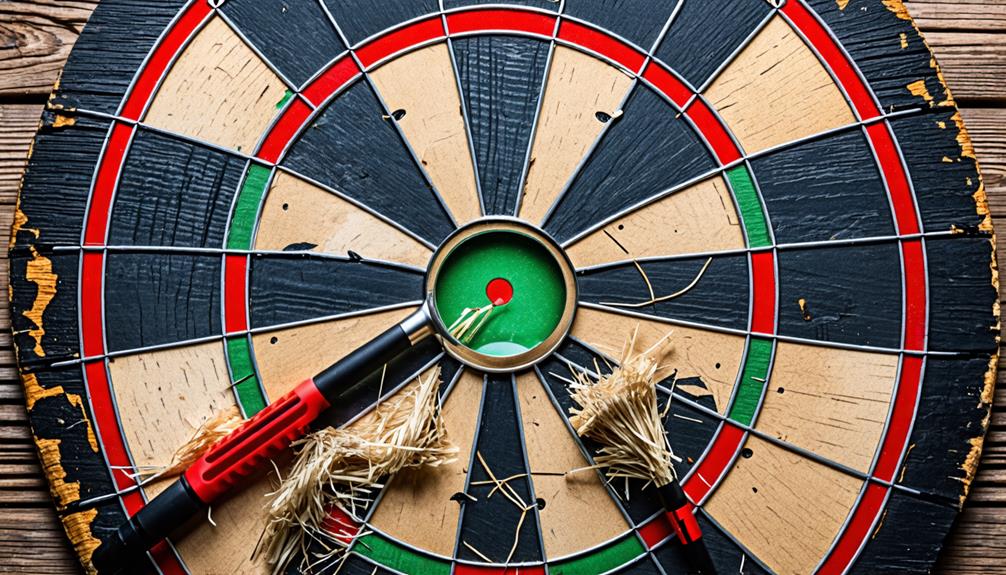
Regularly inspecting your dartboard for damage ensures optimal gameplay and helps prevent further deterioration. Begin by examining for loose staples or damaged segments, as these can significantly impact your performance. A loose number ring is another crucial aspect to check, as it can cause misalignment and uneven wear on the board. Closely inspect for signs of damage, such as deep punctures or frayed areas, particularly in high-traffic zones like the bullseye and 20 segments. These areas are more susceptible to wear and should be addressed promptly.
Additionally, inspect the back of the dartboard for moisture damage or warping, as these issues can compromise the board's structural integrity and performance. Make it a habit to remove any loose fibers from the surface regularly. This simple action not only maintains the board's appearance but also extends its lifespan.
Maintain Your Darts
To keep your darts in optimal condition, regularly inspect the tips for burrs or damage. Sharp, well-maintained points not only enhance your performance but also minimize wear on your dartboard. Additionally, clean your darts after each session to maintain their effectiveness and longevity.
Tip Sharpness Importance
Maintaining the sharpness of your dart tips is crucial for optimal performance and preserving the integrity of your dartboard. Sharp dart tips allow for smooth insertion and removal from the board, minimizing damage to the sisal fibers. Regularly checking the sharpness of your dart tips reduces the risk of bounce-outs and prolongs the life of your dartboard.
It's important to strike a balance; tips that are too sharp can cause excessive damage to the dartboard, while dull tips can lead to frustrating bounce-outs. A round-point sharpening method is recommended for maintaining optimal sharpness. Using a bowl-shaped dart sharpener provides consistent results, ensuring your tips remain in top condition.
Inspect for Burrs
Regularly inspect your dart tips for burrs, as these sharp edges can damage the sisal fibers of your dartboard when you remove the darts. Maintaining smooth dart tips is crucial to prolong the lifespan of both your darts and your board. Aim to check your dart tips at least once a month or during each rotation of the dartboard. If you spot any burrs, use a bowl-shaped dart sharpener to smooth them out. A well-maintained, rounded point minimizes board wear and reduces bounce-outs, enhancing your overall gameplay.
Here's a quick reference table to help you remember the key points:
| Action | Frequency | Benefits |
|---|---|---|
| Inspect dart tips | Once a month | Prevents damage to board |
| Smooth out burrs | As needed | Improves dart performance |
| Rotate dartboard | Every few weeks | Ensures even wear on board |
Keeping your dart tips in good condition not only protects your board but also improves your throwing accuracy and performance. Don't overlook this essential maintenance step!
Regular Dart Cleaning
Maintaining burr-free dart tips is just the beginning; regular cleaning ensures peak performance and extends the life of your darts. Regularly inspect your darts for burrs or sharp edges, as these imperfections can damage the sisal fibers of your dartboard and lead to premature wear. To keep your tips smooth, use a bowl-shaped dart sharpener, applying steady, circular motions for about 10-20 seconds.
After sharpening, clean your darts with mild soap and water to remove grease or residue that can affect their performance and lifespan. Avoid using grooved dart tips, as they can increase wear on your dartboard, necessitating more frequent replacements. Proper storage is also crucial. Keep your darts organized in a dart caddy to prevent damage and ensure quick access during play.
Optimize Your Setup
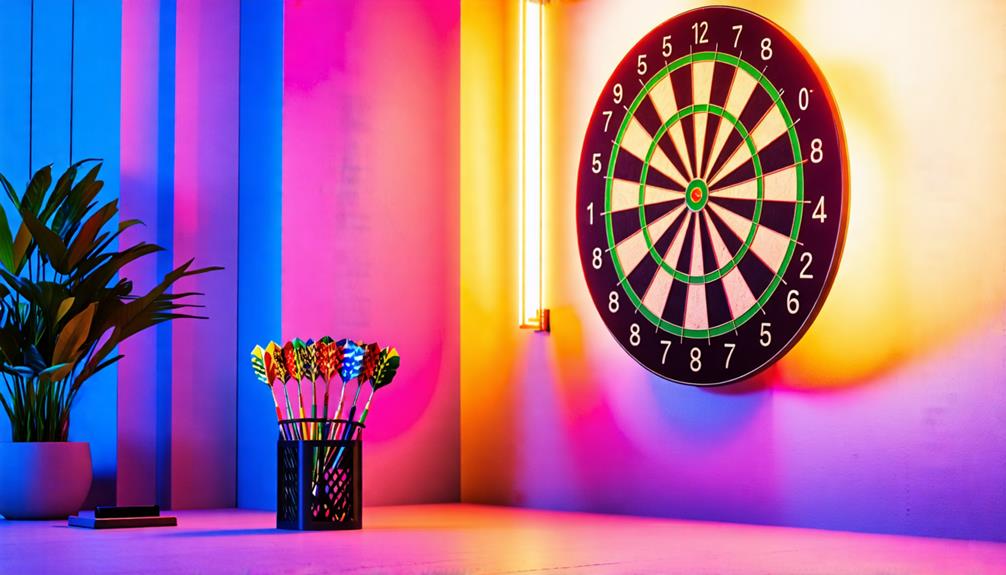
To optimize your dartboard setup, start by placing the throw line at the correct distance for accurate throws. Consider essential accessories like a dartboard surround and a cabinet to protect your equipment and keep the area organized. Proper lighting is also crucial, as it enhances visibility and the overall playing experience.
Ideal Throw Line Placement
Finding the right throw line placement is crucial for ensuring a consistent and enjoyable dart-playing experience. The ideal distances vary based on the type of darts you use. For steel tip darts, the throw line should be 7 feet 9.25 inches (237 cm) from the front of the dartboard. For electronic darts, set the throw line at 8 feet (243.84 cm).
To optimize your setup, consider these tips:
- Position the dartboard's center at 5 feet 8 inches (173 cm) from the floor.
- Use a lighted throw line, such as the Viper Lighted Dart Throw Line, for better visibility.
- Mark the throw line with a durable edge marker, like the Viper Edge Throw Line Marker.
- Ensure the area around the dartboard is free from obstructions for safe play.
Essential Accessories Overview
Optimizing your dart-playing setup requires essential accessories that enhance performance and protect your equipment. A well-chosen dartboard and accessories can elevate your gameplay experience while ensuring your darts remain in top condition.
Start with the Viper Lighted Dart Throw Line ($24.99), which improves visibility in low-light conditions, aiding in accurate throws. Next, consider investing in Viper Sure Grip Darts ($13.99), featuring a black soft tip design for better handling and control, significantly boosting your performance. To maintain proper throw distance and adhere to standard regulations, the Viper Edge Throw Line Marker ($7.99) is indispensable.
For the care and organization of your darts, use a Viper Dart Caddy ($24.99). This storage solution keeps your darts accessible and extends their lifespan. Additionally, consider dartboard surrounds or cabinets to protect your walls and enhance the aesthetic appeal of your setup. With these essential accessories, you'll be ready to enjoy your dart games while keeping your equipment in prime condition.
Proper Lighting Considerations
Proper lighting is crucial for an optimal dart-playing experience, as it enhances visibility and reduces eye strain. To ensure you have the best setup, consider the following key factors:
- Avoid direct sunlight: Prolonged exposure to direct sunlight can cause discoloration and damage to the dartboard.
- Use diffused lighting: LED lights are ideal for creating even illumination without harsh shadows.
- Install a lighted throw line: This improves visibility and helps you maintain accurate distance and technique, especially in low-light conditions.
- Position your dartboard in a well-lit area: Ensure the area is well-lit to optimize light exposure while avoiding glare on the board.
- Check for flickering lights: Ensure there are no flickering lights or uneven brightness, as these can be distracting and reduce your focus during play.
Create a Clean Playing Space
Creating a clean playing space around your dartboard not only protects your equipment but also enhances your overall gaming experience. A clean environment prevents food residue and grease from transferring to your darts, which can damage the board and affect gameplay. To maintain this space, you should regularly use napkins, paper towels, or sanitized wipes. This keeps surfaces free from dirt and contaminants, making your play area more enjoyable and hygienic.
Here's a quick reference table to help you maintain a clean dart space:
| Task | Frequency |
|---|---|
| Wipe down surfaces | After each session |
| Organize equipment | Weekly |
| Check for pests | Monthly |
| Clean darts | After every use |
| Dust the dartboard area | Every two weeks |
An organized space with proper storage solutions, like a dart caddy, not only helps prevent damage but also makes it easier to find your gear. Regular cleaning will prolong the life of your dartboard and encourage more frequent play, enhancing your overall enjoyment of the game.
Protect From Environmental Factors
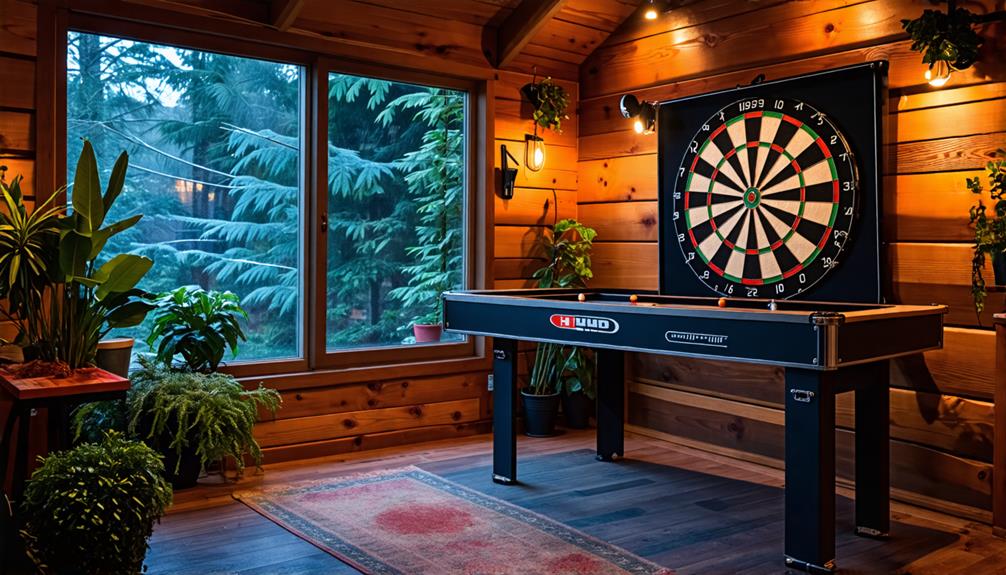
To keep your dartboard in top condition, it's essential to protect it from environmental factors that can cause damage. Direct sunlight can lead to discoloration and brittle fibers, so position your board away from windows or use a dart cabinet. High humidity levels, especially in basements, can foster mold growth and deteriorate the board's material, making it crucial to maintain a dry environment.
Here are some tips to protect your dartboard:
- Use a protective cover when it's not in use to guard against dust and dirt.
- Monitor humidity levels regularly, aiming for a consistent, dry atmosphere.
- Avoid bright lighting directly over the board; opt for diffused lighting instead.
- Keep the board away from heat sources that can alter its material properties.
Conclusion
By following these dartboard maintenance tips, you can keep your board in excellent condition and enhance your gameplay experience. Regularly rotating your board, keeping it dry, and cleaning it properly will help prevent damage and extend its lifespan. Additionally, inspect for any loose staples and maintain your darts to ensure maximum performance. With a little effort, you'll create an ideal setup and a pristine playing space, allowing you to get the most out of every game.
